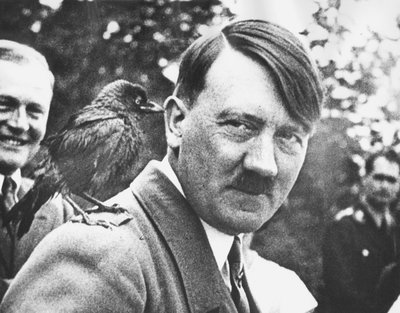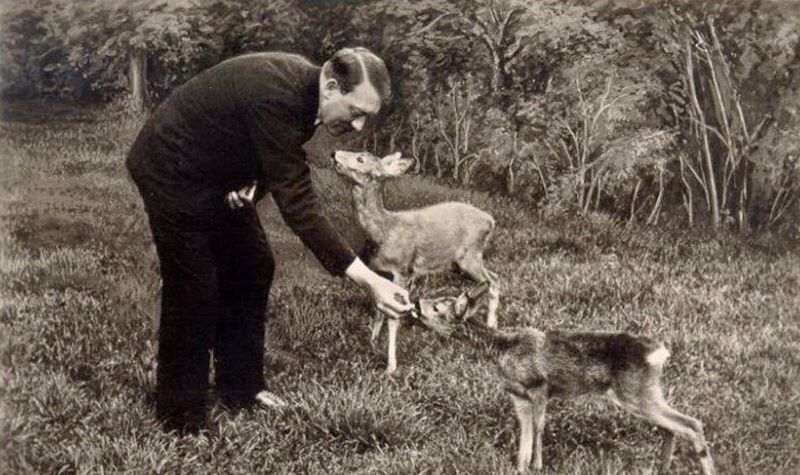
For the Nazis, the life of one person did not mean anything. They were ready to exterminate entire nations. Experiments on living people were normal for them, in which they did not see anything immoral. But all this rigidity towards people did not prevent them from creating the most developed animal protection legislation in history.
The Nazi party, even before coming to power, proposed banning vivisection. True, then her initiative was not supported. But as soon as Hitler became the head of state, a number of tough animal protection laws were passed. So, experiments on live animals were limited, strict rules were set for slaughtering livestock. They banned the use of animals in the circus, to do them operations without anesthesia. There were also restrictions for hunters. The Nazi authorities strictly guarded populations that were threatened with extinction. Amazingly, the Third Reich defended animals in a way that no state in the world protects even today.

Even before coming to power, in 1927 in the parliament of the Weimar Republic, the Nazis for the first time in European history raised the question of the prohibition of vivisection, an experiment on a living animal, at the highest level. In 1933, almost immediately after the NSDAP came to power and the establishment of the Nazi regime, a series of strict laws were issued that severely limited vivisection and strict rules for slaughtering livestock. It was also forbidden to keep animals in the circus, to conduct operations on animals without anesthesia and anesthesia.
Soon, German Goering announced on the radio the end of “the unbearable torture and suffering of animals during the experiments and threatened to” imprison those who still consider our lesser brothers to be inanimate property. ” Perhaps this was one of the most honest things he said. These laws were only the beginning, and soon the Third Reich began to become the most humane country for animals.
Following this zoo-protection package, new decrees followed. In 1935, laws on hunting were amended. She, of course, was not banned, but strict control over the hunters was introduced. Populations in which the existence was under threat, the Reich very strictly guarded.
In 1938, the Nazis even banned the live cooking of crustaceans – crayfish, lobsters and lobsters. In the same 1938, instructions were issued for senior SS officers to switch to a vegetarian diet, and 32 hours of animal protection discipline were introduced in educational institutions.
No country in the world today protects animals in the way that the Hitler regime defended them at the start of World War II.
Also in the Third Reich a cult of vegetarianism was created. By personal example, Hitler taught the Germans to a vegetable diet. It is still not clear to the end whether he was really a vegetarian or whether Goebbels invented it for the sake of his image. There is a lot of evidence that Hitler loved to enjoy Bavarian sausages and stuffed pigeons – but before ordinary Germans he always presented himself as a vegetarian. However, it was likely that he really limited meat consumption.
Be that as it may, the Nazi propaganda machine actively created the image of a vegetarian for Hitler, and for all other leaders – the images of real animal friends. Every prominent Nazi had a pet, most often a dog. But Goering, for example, had tame lions.

Many of these Nazi actions were discriminatory. For example, after the 1933 laws on slaughtering livestock, the kosher method of slaughtering livestock became outlawed – Shkhit. Animal protection policies could easily cover other political frauds. The Jews were labeled animal tormentors. However, this was not an end in itself. Vegetarianism and the cult of humane treatment of animals were parts of Nazi ideology. But how did this kind, humane element suddenly become part of the hate doctrine?
Why was the regime that set up experiments on people guarded animals so carefully?
The Nazis believed that man is the crown of the development of nature, the peak in the pyramid of species, but still part of nature and the animal world. Nazism tried to be more natural than liberalism and socialism, which grew out of European Humanism, in which man was considered not to be part of the animal world, but his master.
The Nazis perceived humanity as cattle in which there are different breeds. Aryans are a “good” breed that is worthy of existence, the vanguard of the species. But it can also be done better – eugenics serves for this. Therefore, the Nazis considered it necessary, for example, to sterilize people with genetic abnormalities. But Jews and Gypsies are a “bad” tribe that needs to be destroyed. By the way, many Nazi scientists considered eating meat to be one of the reasons for the global damage to genes in many nations – vegetarianism was justified. The “bad” breeds of people, that is, Untermensch peoples, are like stunted cows and weak bulls, which, when breeding, reduce milk yield in the whole herd and spoil genetics.
And animals, especially wild ones, do not have “bad” breeds. Their development is governed by the laws of nature and natural selection. In the world of animals there is no “non-innocent,” because nature itself cuts off the species of weak and defective representatives. Therefore, every beast is an Aryan. And it turns out that the experiment on the Aryan beast is more immoral and inhumane than the experiment on the person of the “bad” breed.
And that is why Dr. Mengele’s lesser-known colleague, Dr. Hans Nathsheim, who compared the reaction to the pentylenetetrazole-causing epileptic seizure in children, adults, and rabbits, did this secretly, as he was afraid to go to jail for cruelty to animals.
Source: save-animals.info

Leave a Reply
You must be logged in to post a comment.